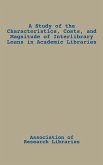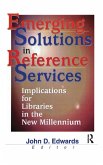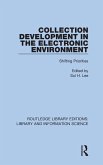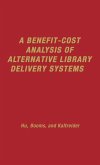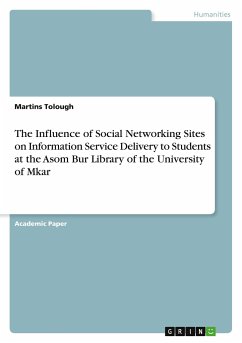Janet Brennan Croft
Legal Solutions in Electronic Reserves and the Electronic Delivery of Interlibrary Loan
Janet Brennan Croft
Legal Solutions in Electronic Reserves and the Electronic Delivery of Interlibrary Loan
- Gebundenes Buch
- Merkliste
- Auf die Merkliste
- Bewerten Bewerten
- Teilen
- Produkt teilen
- Produkterinnerung
- Produkterinnerung
Legal Solutions in Electronic Reserves and the Electronic Delivery of Interlibrary Loan guides you through the process of developing policies to protect you, your library, and your patrons. From copyright usage and licensing to the impact of the USA Patriot Act, this vital resource offers suggestions and advice to ensure your library can offer the best services to your patrons while staying within the boundaries of the law. This book includes the texts of the most important laws and guidelines, a list of significant cases on file, information on pending legislations, and a bibliography of useful print and Internet resources.…mehr
Andere Kunden interessierten sich auch für
![A Study of the Characteristics, Costs, and Magnitude of Interlibrary Loans in Academic Libraries A Study of the Characteristics, Costs, and Magnitude of Interlibrary Loans in Academic Libraries]() Vernon E. PalmourA Study of the Characteristics, Costs, and Magnitude of Interlibrary Loans in Academic Libraries79,99 €
Vernon E. PalmourA Study of the Characteristics, Costs, and Magnitude of Interlibrary Loans in Academic Libraries79,99 €![Emerging Solutions in Reference Services Emerging Solutions in Reference Services]() John D. EdwardsEmerging Solutions in Reference Services112,99 €
John D. EdwardsEmerging Solutions in Reference Services112,99 €![BIALL Handbook of Legal Information Management BIALL Handbook of Legal Information Management]() Loyita WorleyBIALL Handbook of Legal Information Management169,99 €
Loyita WorleyBIALL Handbook of Legal Information Management169,99 €![Collection Development in the Electronic Environment Collection Development in the Electronic Environment]() Collection Development in the Electronic Environment116,99 €
Collection Development in the Electronic Environment116,99 €![A Benefit-Cost Analysis of Alternative Library Delivery Systems A Benefit-Cost Analysis of Alternative Library Delivery Systems]() Teh-Wei HuA Benefit-Cost Analysis of Alternative Library Delivery Systems110,99 €
Teh-Wei HuA Benefit-Cost Analysis of Alternative Library Delivery Systems110,99 €![The Influence of Social Networking Sites on Information Service Delivery to Students at the Asom Bur Library of the University of Mkar The Influence of Social Networking Sites on Information Service Delivery to Students at the Asom Bur Library of the University of Mkar]() Martins ToloughThe Influence of Social Networking Sites on Information Service Delivery to Students at the Asom Bur Library of the University of Mkar42,95 €
Martins ToloughThe Influence of Social Networking Sites on Information Service Delivery to Students at the Asom Bur Library of the University of Mkar42,95 €![Marketing and Promoting Electronic Resources Marketing and Promoting Electronic Resources]() Marketing and Promoting Electronic Resources108,99 €
Marketing and Promoting Electronic Resources108,99 €-
-
-
Legal Solutions in Electronic Reserves and the Electronic Delivery of Interlibrary Loan guides you through the process of developing policies to protect you, your library, and your patrons. From copyright usage and licensing to the impact of the USA Patriot Act, this vital resource offers suggestions and advice to ensure your library can offer the best services to your patrons while staying within the boundaries of the law. This book includes the texts of the most important laws and guidelines, a list of significant cases on file, information on pending legislations, and a bibliography of useful print and Internet resources.
Produktdetails
- Produktdetails
- Verlag: Routledge
- Seitenzahl: 104
- Erscheinungstermin: 6. Oktober 2004
- Englisch
- Abmessung: 235mm x 157mm x 10mm
- Gewicht: 314g
- ISBN-13: 9780789025586
- ISBN-10: 0789025582
- Artikelnr.: 21699811
- Herstellerkennzeichnung
- Libri GmbH
- Europaallee 1
- 36244 Bad Hersfeld
- gpsr@libri.de
- Verlag: Routledge
- Seitenzahl: 104
- Erscheinungstermin: 6. Oktober 2004
- Englisch
- Abmessung: 235mm x 157mm x 10mm
- Gewicht: 314g
- ISBN-13: 9780789025586
- ISBN-10: 0789025582
- Artikelnr.: 21699811
- Herstellerkennzeichnung
- Libri GmbH
- Europaallee 1
- 36244 Bad Hersfeld
- gpsr@libri.de
Janet Brennan Croft
* Acknowledgments
* Introduction
* Chapter 1. Copyright Basics
* 1. What Laws Cover Copyright for Librarians and Educators?
* 2. Securing Copyright: What Is Protected by Copyright
* 3. Rights of the Copyright Holder
* 4. Expiration of Copyright
* 5. Fair Use
* 6. Special Allowances for Library Copying, Reserves, Interlibrary
Loan, and Teaching
* 7. Guidelines (CONTU, CONFU)
* 8. Contracts vs. Copyright Law: Licensing and UCITA
* 9. Penalties
* Chapter 2. Confidentiality Basics
* 1. State Regulations
* 2. Institutional Regulations
* 3. USA PATRIOT Act
* 4. Records-Retention Policies
* Chapter 3. Electronic Reserves
* 1. Electronic vs. Physical Reserves
* Location and Access
* Classification
* Circulation
* Use of Service
* Access in Time
* Access in Space
* Patron Records
* Copying
* 2. Developing an Electronic Reserves Legal Policy
* Subsequent Semesters
* Storage
* Limited Access
* Confidentiality of Patron Records
* Copyright Warning
* Responsibility for Seeking Permissions
* Library Portion of Permission Fees
* Use While Seeking Permissions
* Limits on Amount of Material from Each Title, Etc.
* Explaining Copyright to Instructors
* 3. Negotiating Permissions for Electronic Reserve Use
* 4. Negotiating Database Contracts to Provide for Electronic Reserve
Use
* 5. Cases
* 6. Current Legislative Issues
* TEACH Act
* UCITA
* DMCA
* Chapter 4. Electronic Delivery of Interlibrary Loan
* 1. Electronic vs. Physical Delivery of Interlibrary Loan
* Location and Access
* Circulation
* Use of Service
* Patron Records
* Copying
* 2. Developing an Interlibrary Loan Legal Policy
* The Suggestion of Five
* Secure Delivery System
* Confidentiality of Records
* Copyright Notices
* Fees
* 3. Negotiating Permissions for Interlibrary Loan Use
* 4. Negotiating Database Contracts for Interlibrary Loan Use
* 5. Cases
* 6. Current Legislative Issues
* UCITA
* USA PATRIOT Act
* Chapter 5. Conclusion
* Appendix 1. Copyright Law
* Section 107. Limitations on Exclusive Rights: Fair Use
* Section 108. Limitations on Exclusive Rights: Reproduction by
Libraries and Archives
* Section 109. Limitations on Exclusive Rights: Effect of Transfer of
Particular Copy or Phonorecord
* Section 110. Limitations on Exclusive Rights: Exemption of Certain
Performances and Displays
* Agreement on Guidelines for Classroom Copying in Not-for-Profit
Educational Institutions with Respect to Books and Periodicals
* Guidelines
* CONTU Guidelines on Photocopying Under Interlibrary Loan Arrangements
* CONFU Fair-Use Guidelines for Electronic Reserve Systems (Not
Approved by All Parties; for Guidance Only)
* American Library Association Model Policy Concerning College and
University Photocopying for Classroom, Research, and Library Reserve
Use (Section on Reserves)
* Appendix 2. The Public Domain and Free E-Material
* The Public Domain
* Sources of Electronic Out-of-Copyright Material
* Appendix 3. Tools
* Sources of Permissions
* Copyright Resources on the Web
* Reserves Resources
* Interlibrary Loan Resources
* List-Servs and Discussion Groups
* Bibliography
* Cases Cited
* Works Cited
* Index
* Reference Notes Included
* Introduction
* Chapter 1. Copyright Basics
* 1. What Laws Cover Copyright for Librarians and Educators?
* 2. Securing Copyright: What Is Protected by Copyright
* 3. Rights of the Copyright Holder
* 4. Expiration of Copyright
* 5. Fair Use
* 6. Special Allowances for Library Copying, Reserves, Interlibrary
Loan, and Teaching
* 7. Guidelines (CONTU, CONFU)
* 8. Contracts vs. Copyright Law: Licensing and UCITA
* 9. Penalties
* Chapter 2. Confidentiality Basics
* 1. State Regulations
* 2. Institutional Regulations
* 3. USA PATRIOT Act
* 4. Records-Retention Policies
* Chapter 3. Electronic Reserves
* 1. Electronic vs. Physical Reserves
* Location and Access
* Classification
* Circulation
* Use of Service
* Access in Time
* Access in Space
* Patron Records
* Copying
* 2. Developing an Electronic Reserves Legal Policy
* Subsequent Semesters
* Storage
* Limited Access
* Confidentiality of Patron Records
* Copyright Warning
* Responsibility for Seeking Permissions
* Library Portion of Permission Fees
* Use While Seeking Permissions
* Limits on Amount of Material from Each Title, Etc.
* Explaining Copyright to Instructors
* 3. Negotiating Permissions for Electronic Reserve Use
* 4. Negotiating Database Contracts to Provide for Electronic Reserve
Use
* 5. Cases
* 6. Current Legislative Issues
* TEACH Act
* UCITA
* DMCA
* Chapter 4. Electronic Delivery of Interlibrary Loan
* 1. Electronic vs. Physical Delivery of Interlibrary Loan
* Location and Access
* Circulation
* Use of Service
* Patron Records
* Copying
* 2. Developing an Interlibrary Loan Legal Policy
* The Suggestion of Five
* Secure Delivery System
* Confidentiality of Records
* Copyright Notices
* Fees
* 3. Negotiating Permissions for Interlibrary Loan Use
* 4. Negotiating Database Contracts for Interlibrary Loan Use
* 5. Cases
* 6. Current Legislative Issues
* UCITA
* USA PATRIOT Act
* Chapter 5. Conclusion
* Appendix 1. Copyright Law
* Section 107. Limitations on Exclusive Rights: Fair Use
* Section 108. Limitations on Exclusive Rights: Reproduction by
Libraries and Archives
* Section 109. Limitations on Exclusive Rights: Effect of Transfer of
Particular Copy or Phonorecord
* Section 110. Limitations on Exclusive Rights: Exemption of Certain
Performances and Displays
* Agreement on Guidelines for Classroom Copying in Not-for-Profit
Educational Institutions with Respect to Books and Periodicals
* Guidelines
* CONTU Guidelines on Photocopying Under Interlibrary Loan Arrangements
* CONFU Fair-Use Guidelines for Electronic Reserve Systems (Not
Approved by All Parties; for Guidance Only)
* American Library Association Model Policy Concerning College and
University Photocopying for Classroom, Research, and Library Reserve
Use (Section on Reserves)
* Appendix 2. The Public Domain and Free E-Material
* The Public Domain
* Sources of Electronic Out-of-Copyright Material
* Appendix 3. Tools
* Sources of Permissions
* Copyright Resources on the Web
* Reserves Resources
* Interlibrary Loan Resources
* List-Servs and Discussion Groups
* Bibliography
* Cases Cited
* Works Cited
* Index
* Reference Notes Included
* Acknowledgments
* Introduction
* Chapter 1. Copyright Basics
* 1. What Laws Cover Copyright for Librarians and Educators?
* 2. Securing Copyright: What Is Protected by Copyright
* 3. Rights of the Copyright Holder
* 4. Expiration of Copyright
* 5. Fair Use
* 6. Special Allowances for Library Copying, Reserves, Interlibrary
Loan, and Teaching
* 7. Guidelines (CONTU, CONFU)
* 8. Contracts vs. Copyright Law: Licensing and UCITA
* 9. Penalties
* Chapter 2. Confidentiality Basics
* 1. State Regulations
* 2. Institutional Regulations
* 3. USA PATRIOT Act
* 4. Records-Retention Policies
* Chapter 3. Electronic Reserves
* 1. Electronic vs. Physical Reserves
* Location and Access
* Classification
* Circulation
* Use of Service
* Access in Time
* Access in Space
* Patron Records
* Copying
* 2. Developing an Electronic Reserves Legal Policy
* Subsequent Semesters
* Storage
* Limited Access
* Confidentiality of Patron Records
* Copyright Warning
* Responsibility for Seeking Permissions
* Library Portion of Permission Fees
* Use While Seeking Permissions
* Limits on Amount of Material from Each Title, Etc.
* Explaining Copyright to Instructors
* 3. Negotiating Permissions for Electronic Reserve Use
* 4. Negotiating Database Contracts to Provide for Electronic Reserve
Use
* 5. Cases
* 6. Current Legislative Issues
* TEACH Act
* UCITA
* DMCA
* Chapter 4. Electronic Delivery of Interlibrary Loan
* 1. Electronic vs. Physical Delivery of Interlibrary Loan
* Location and Access
* Circulation
* Use of Service
* Patron Records
* Copying
* 2. Developing an Interlibrary Loan Legal Policy
* The Suggestion of Five
* Secure Delivery System
* Confidentiality of Records
* Copyright Notices
* Fees
* 3. Negotiating Permissions for Interlibrary Loan Use
* 4. Negotiating Database Contracts for Interlibrary Loan Use
* 5. Cases
* 6. Current Legislative Issues
* UCITA
* USA PATRIOT Act
* Chapter 5. Conclusion
* Appendix 1. Copyright Law
* Section 107. Limitations on Exclusive Rights: Fair Use
* Section 108. Limitations on Exclusive Rights: Reproduction by
Libraries and Archives
* Section 109. Limitations on Exclusive Rights: Effect of Transfer of
Particular Copy or Phonorecord
* Section 110. Limitations on Exclusive Rights: Exemption of Certain
Performances and Displays
* Agreement on Guidelines for Classroom Copying in Not-for-Profit
Educational Institutions with Respect to Books and Periodicals
* Guidelines
* CONTU Guidelines on Photocopying Under Interlibrary Loan Arrangements
* CONFU Fair-Use Guidelines for Electronic Reserve Systems (Not
Approved by All Parties; for Guidance Only)
* American Library Association Model Policy Concerning College and
University Photocopying for Classroom, Research, and Library Reserve
Use (Section on Reserves)
* Appendix 2. The Public Domain and Free E-Material
* The Public Domain
* Sources of Electronic Out-of-Copyright Material
* Appendix 3. Tools
* Sources of Permissions
* Copyright Resources on the Web
* Reserves Resources
* Interlibrary Loan Resources
* List-Servs and Discussion Groups
* Bibliography
* Cases Cited
* Works Cited
* Index
* Reference Notes Included
* Introduction
* Chapter 1. Copyright Basics
* 1. What Laws Cover Copyright for Librarians and Educators?
* 2. Securing Copyright: What Is Protected by Copyright
* 3. Rights of the Copyright Holder
* 4. Expiration of Copyright
* 5. Fair Use
* 6. Special Allowances for Library Copying, Reserves, Interlibrary
Loan, and Teaching
* 7. Guidelines (CONTU, CONFU)
* 8. Contracts vs. Copyright Law: Licensing and UCITA
* 9. Penalties
* Chapter 2. Confidentiality Basics
* 1. State Regulations
* 2. Institutional Regulations
* 3. USA PATRIOT Act
* 4. Records-Retention Policies
* Chapter 3. Electronic Reserves
* 1. Electronic vs. Physical Reserves
* Location and Access
* Classification
* Circulation
* Use of Service
* Access in Time
* Access in Space
* Patron Records
* Copying
* 2. Developing an Electronic Reserves Legal Policy
* Subsequent Semesters
* Storage
* Limited Access
* Confidentiality of Patron Records
* Copyright Warning
* Responsibility for Seeking Permissions
* Library Portion of Permission Fees
* Use While Seeking Permissions
* Limits on Amount of Material from Each Title, Etc.
* Explaining Copyright to Instructors
* 3. Negotiating Permissions for Electronic Reserve Use
* 4. Negotiating Database Contracts to Provide for Electronic Reserve
Use
* 5. Cases
* 6. Current Legislative Issues
* TEACH Act
* UCITA
* DMCA
* Chapter 4. Electronic Delivery of Interlibrary Loan
* 1. Electronic vs. Physical Delivery of Interlibrary Loan
* Location and Access
* Circulation
* Use of Service
* Patron Records
* Copying
* 2. Developing an Interlibrary Loan Legal Policy
* The Suggestion of Five
* Secure Delivery System
* Confidentiality of Records
* Copyright Notices
* Fees
* 3. Negotiating Permissions for Interlibrary Loan Use
* 4. Negotiating Database Contracts for Interlibrary Loan Use
* 5. Cases
* 6. Current Legislative Issues
* UCITA
* USA PATRIOT Act
* Chapter 5. Conclusion
* Appendix 1. Copyright Law
* Section 107. Limitations on Exclusive Rights: Fair Use
* Section 108. Limitations on Exclusive Rights: Reproduction by
Libraries and Archives
* Section 109. Limitations on Exclusive Rights: Effect of Transfer of
Particular Copy or Phonorecord
* Section 110. Limitations on Exclusive Rights: Exemption of Certain
Performances and Displays
* Agreement on Guidelines for Classroom Copying in Not-for-Profit
Educational Institutions with Respect to Books and Periodicals
* Guidelines
* CONTU Guidelines on Photocopying Under Interlibrary Loan Arrangements
* CONFU Fair-Use Guidelines for Electronic Reserve Systems (Not
Approved by All Parties; for Guidance Only)
* American Library Association Model Policy Concerning College and
University Photocopying for Classroom, Research, and Library Reserve
Use (Section on Reserves)
* Appendix 2. The Public Domain and Free E-Material
* The Public Domain
* Sources of Electronic Out-of-Copyright Material
* Appendix 3. Tools
* Sources of Permissions
* Copyright Resources on the Web
* Reserves Resources
* Interlibrary Loan Resources
* List-Servs and Discussion Groups
* Bibliography
* Cases Cited
* Works Cited
* Index
* Reference Notes Included


